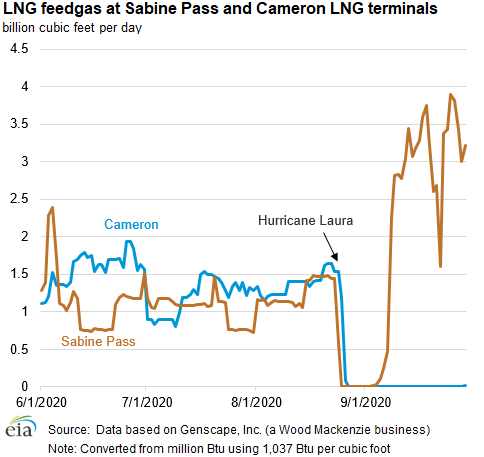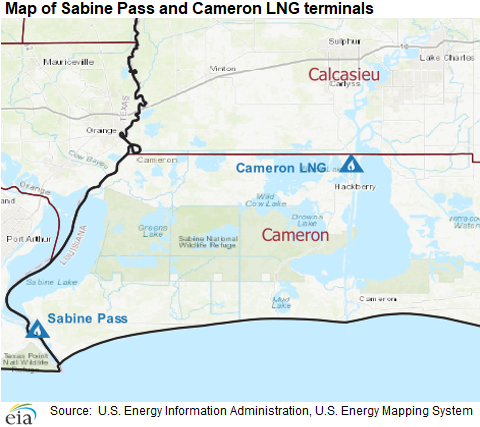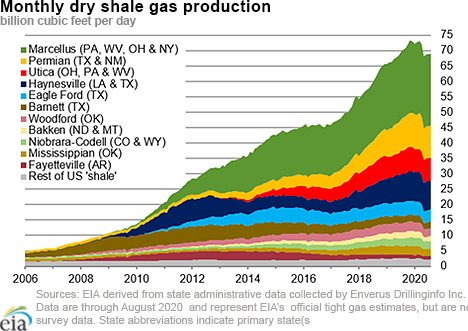In the News:
After Hurricane Laura, Cameron LNG remains offline but Sabine Pass exports resume
The Sabine Pass and Cameron LNG natural gas liquefaction and export terminals located in Louisiana were both affected by Hurricane Laura, which made landfall as a Category 4 hurricane on August 27, 2020. Although both liquefied natural gas (LNG) facilities survived the storm with minimal damage, damage to the electrical and marine infrastructure around the Cameron LNG facility has persisted, and the facility remains offline. Feedgas deliveries to the Sabine Pass terminal resumed on September 2, according to Genscape (a Wood Mackenzie business), and the facility shipped its first post-hurricane cargo two weeks after the storm on September 11.
Because of differences in how each facility sources electric power, the facilities have faced different impacts as a result of the hurricane. At the Sabine Pass terminal, onsite generators consume natural gas to provide the facility with electric power. The Cameron LNG terminal purchases electricity offsite from the local electric utility, Entergy Gulf States Louisiana. Approximately 93,000 customers, including the Cameron LNG facility, were left without power after Hurricane Laura made landfall and damaged electricity transmission infrastructure.
Entergy restored partial electric power to Cameron LNG on September 18, 2020. Currently, the facility is testing equipment in order to restart the liquefaction process. It resumed receiving feedgas on September 27. Feedstock deliveries to the facility averaged 11.6 million cubic feet per day (MMcf/d) on September 27 and 28, and they increased to 20.2 MMcf/d on September 29, according to Genscape. However, the Calcasieu Ship Channel, where the terminal is sited, remains partially blocked. The intracoastal waterways around the Cameron LNG facility can currently only accommodate movement of vessels with draft up to 30 feet, whereas most LNG vessels have a 40-foot draft. The channel must still be dredged for LNG vessels to be able to transit without restrictions.
Cheniere Energy’s Sabine Pass LNG export terminal is the largest in the United States and has a capacity of approximately 30 million tons of LNG per year. The first of Sabine Pass’s five operating liquefaction units (trains) came online in February 2016, and the most recent one began commercial operations in March 2019. Sempra’s Cameron LNG terminal began operation in May 2019, and its third liquefaction train started operations in May 2020. With that train operating, Cameron LNG’s capacity is 12 million tons of LNG per year.
Overview:
(For the week ending Wednesday, September 30, 2020)
- Natural gas spot prices fell at most locations this report week (Wednesday, September 23 to Wednesday, September 30). The Henry Hub spot price fell from $1.74 per million British thermal units (MMBtu) last Wednesday to $1.63/MMBtu yesterday.
- At the New York Mercantile Exchange (Nymex), the October 2020 contract expired Monday at $2.101/MMBtu, down 2¢/MMBtu from last Wednesday. The November 2020 contract price decreased to $2.527/MMBtu, down 27¢/MMBtu from last Wednesday to yesterday. The price of the 12-month strip averaging November 2020 through October 2021 futures contracts declined 7¢/MMBtu to $2.901/MMBtu.
- The net injections to working gas totaled 76 billion cubic feet (Bcf) for the week ending September 25. Working natural gas stocks totaled 3,756 Bcf, which is 14% more than the year-ago level and 12% more than the five-year (2015–19) average for this week.
- The natural gas plant liquids composite price at Mont Belvieu, Texas, rose by 5¢/MMBtu, averaging $4.80/MMBtu for the week ending September 30. The prices of propane and butane fell by 1% and 7%, respectively. The prices of isobutane and ethane rose by 1% and 8%, respectively. The price of natural gasoline remained flat week over week.
- According to Baker Hughes, for the week ending Tuesday, September 22, the natural gas rig count increased by 2 to 75. The number of oil-directed rigs rose by 4 to 183. The total rig count increased by 6, and it now stands at 261.
Prices/Supply/Demand:
Prices fall at most locations. This report week (Wednesday, September 23 to Wednesday, September 30), the Henry Hub spot price fell 11¢ from $1.74/MMBtu last Wednesday to a low of $1.63/MMBtu yesterday. Temperatures were generally close to normal across the Lower 48 states with warmer-than-normal temperatures in the Northeast and Southwest. At the Chicago Citygate, the price decreased 29¢ from $1.74/MMBtu last Wednesday to $1.45/MMBtu yesterday.
California prices rise with high temperatures in Southern California at the end of the report week. The price at PG&E Citygate in Northern California rose 7¢, up from a low of $3.77/MMBtu last Wednesday to $3.84/MMBtu yesterday. The price at SoCal Citygate in Southern California increased $1.34 from $2.86/MMBtu last Wednesday to $4.20/MMBtu yesterday after reaching a high of $5.25/MMBtu on Tuesday amid triple digit temperatures and an increase in cooling demand at the end of the report week. Following three days of natural gas storage withdrawals during the report week, storage levels in the Southern California Gas system are now 78.8 Bcf, 5.4 Bcf higher than a year ago.
Northeast prices fall. At the Algonquin Citygate, which serves Boston-area consumers, the price went down 33¢ from $1.46/MMBtu last Wednesday to a low of $1.13/MMBtu yesterday. At the Transcontinental Pipeline Zone 6 trading point for New York City, the price decreased 33¢ from $1.28/MMBtu last Wednesday to a low of $0.95/MMBtu yesterday. Stronger natural gas production in the Northeast and higher-than-normal storage levels from Dominion and Columbia Gas could be contributing to the recent lower prices in the Northeast, according to S&P Global Platts.
The Tennessee Zone 4 Marcellus spot price decreased 35¢ from $1.23/MMBtu last Wednesday to $0.88/MMBtu yesterday. The price at Dominion South in southwest Pennsylvania fell 31¢ from $1.26/MMBtu last Wednesday to $0.95/MMBtu yesterday.
Permian Basin discount to the Henry Hub widens throughout the week. The price at the Waha Hub in West Texas, which is located near Permian Basin production activities, averaged $1.39/MMBtu last Wednesday, 35¢/MMBtu lower than the Henry Hub price. Yesterday, the price at the Waha Hub averaged $0.71/MMBtu, 92¢/MMBtu lower than the Henry Hub price. The price decline at the Waha Hub comes as El Paso Natural Gas conducts pipeline maintenance, which restricts gas flows out of the Permian.
Supply rises slightly. According to data from IHS Markit, the average total supply of natural gas rose by 0.6% compared with the previous report week. Dry natural gas production grew by 0.3% compared with the previous report week. Average net imports from Canada increased by 7.5% from last week. Despite the weekly increase, TC Energy is reporting ongoing maintenance on its Gas Transmission Pipeline Northwest from September 29–October 5. Natural gas flows at the Eastport-Kingsgate border crossing in Idaho will be limited to 2 Bcf/d, or 0.6 Bcf/d less than its estimated flow capacity.
Demand rises slightly with gains in the power sector. Total U.S. consumption of natural gas rose by 0.4% compared with the previous report week, according to data from IHS Markit. Natural gas consumed for power generation climbed by 3.8% week over week. In the residential and commercial sectors, consumption declined by 7.5% amid seasonal fall temperatures. Industrial sector consumption decreased by 0.5% week over week. Natural gas exports to Mexico decreased 1.5%. Natural gas deliveries to U.S. liquefied natural gas (LNG) export facilities (LNG pipeline receipts) averaged 6.5 Bcf/d, or 0.45 Bcf/d higher than last week.
U.S. LNG exports increase week over week. Fourteen LNG vessels (eight from Sabine Pass, three from Freeport, two from Corpus Christi, and one from Elba Island) with a combined LNG-carrying capacity of 50 Bcf departed the United States between September 24 and September 30, according to shipping data provided by Marine Traffic.
Cove Point LNG terminal is undergoing a scheduled annual maintenance and exported its last cargo prior to shutting down on September 20.
.Storage:
The net injections into storage totaled 76 Bcf for the week ending September 25, compared with the five-year (2015–19) average net injections of 78 Bcf and last year's net injections of 109 Bcf during the same week. Working natural gas stocks totaled 3,756 Bcf, which is 405 Bcf more than the five-year average and 471 Bcf more than last year at this time.
According to The Desk survey of natural gas analysts, estimates of the weekly net change to working natural gas stocks ranged from net injections of 71 Bcf to 86 Bcf, with a median estimate of 77 Bcf.
The average rate of injections into storage is 6% higher than the five-year average so far in the refill season (April through October). If the rate of injections into storage matched the five-year average of 10.3 Bcf/d for the remainder of the refill season, the total inventory would be 4,128 Bcf on October 31, which is 405 Bcf higher than the five-year average of 3,723 Bcf for that time of year
More storage data and analysis can be found on the Natural Gas Storage Dashboard and the Weekly Natural Gas Storage Report.
See also:
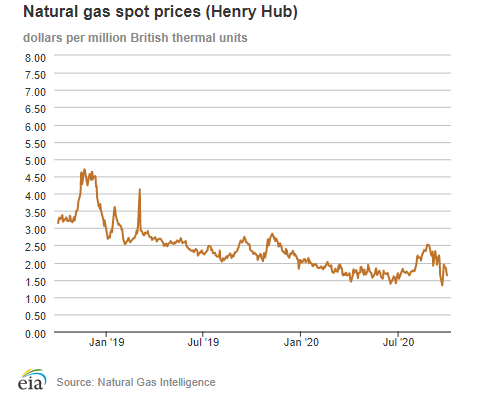
| Spot Prices ($/MMBtu) | Thu, 24-Sep |
Fri, 25-Sep |
Mon, 28-Sep |
Tue, 29-Sep |
Wed, 30-Sep |
|---|---|---|---|---|---|
| Henry Hub | 1.94 | 1.90 | 1.84 | 1.69 | 1.63 |
| New York | 1.36 | 0.99 | 1.40 | 1.18 | 0.95 |
| Chicago | 1.90 | 1.70 | 1.55 | 1.36 | 1.45 |
| Cal. Comp. Avg.* | 3.09 | 3.09 | 3.28 | 3.98 | 3.47 |
| Futures ($/MMBtu) | |||||
| October Contract | 2.248 | 2.139 | 2.101 | Expired | Expired |
| November Contract | 2.899 | 2.807 | 2.795 | 2.561 | 2.527 |
| December Contract | 3.343 | 3.277 | 3.271 | 3.118 | 3.117 |
| *Avg. of NGI's reported prices for: Malin, PG&E Citygate, and Southern California Border Avg. | |||||
| Sources: Natural Gas Intelligence and CME Group as compiled by Bloomberg, L.P. | |||||
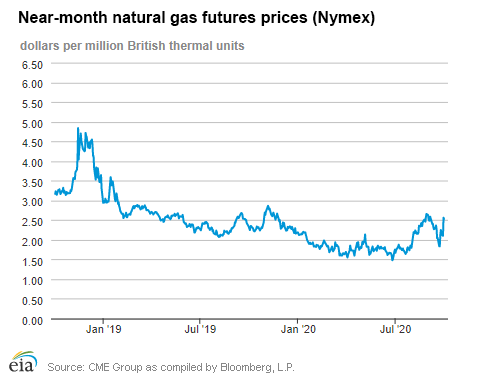
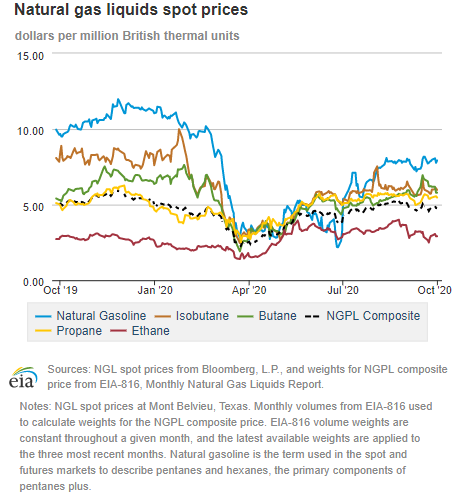
| U.S. natural gas supply - Gas Week: (9/24/20 - 9/30/20) | |||
|---|---|---|---|
Average daily values (Bcf/d): |
|||
this week |
last week |
last year |
|
| Marketed production | 98.7 |
98.3 |
107.2 |
| Dry production | 87.2 |
87.0 |
95.0 |
| Net Canada imports | 3.8 |
3.5 |
4.6 |
| LNG pipeline deliveries | 0.1 |
0.1 |
0.1 |
| Total supply | 91.1 |
90.5 |
99.6 |
|
Source: IHS Markit | |||
| U.S. natural gas consumption - Gas Week: (9/24/20 - 9/30/20) | |||
|---|---|---|---|
Average daily values (Bcf/d): |
|||
this week |
last week |
last year |
|
| U.S. consumption | 60.5 |
60.2 |
64.0 |
| Power | 30.4 |
29.3 |
34.7 |
| Industrial | 21.2 |
21.3 |
20.4 |
| Residential/commercial | 8.9 |
9.6 |
9.0 |
| Mexico exports | 5.9 |
6.0 |
5.7 |
| Pipeline fuel use/losses | 6.5 |
6.4 |
7.1 |
| LNG pipeline receipts | 6.5 |
6.0 |
6.4 |
| Total demand | 79.3 |
78.7 |
83.2 |
|
Source: IHS Markit | |||
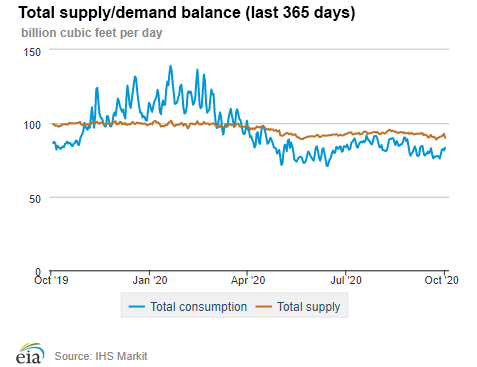
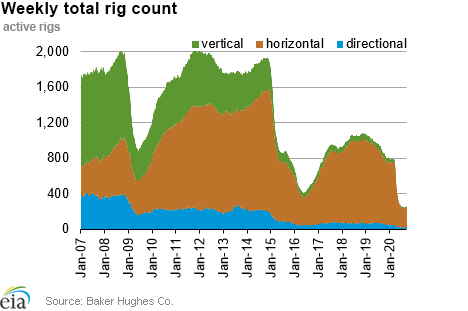
| Rigs | |||
|---|---|---|---|
Tue, September 22, 2020 |
Change from |
||
last week |
last year |
||
| Oil rigs | 183 |
2.2% |
-74.3% |
| Natural gas rigs | 75 |
2.7% |
-48.6% |
| Note: Excludes any miscellaneous rigs | |||
| Rig numbers by type | |||
|---|---|---|---|
Tue, September 22, 2020 |
Change from |
||
last week |
last year |
||
| Vertical | 16 |
-5.9% |
-68.6% |
| Horizontal | 224 |
4.2% |
-70.2% |
| Directional | 21 |
-8.7% |
-63.2% |
| Source: Baker Hughes Co. | |||
| Working gas in underground storage | ||||
|---|---|---|---|---|
Stocks billion cubic feet (Bcf) |
||||
| Region | 2020-09-25 |
2020-09-18 |
change |
|
| East | 872 |
851 |
21 |
|
| Midwest | 1,033 |
1,009 |
24 |
|
| Mountain | 231 |
225 |
6 |
|
| Pacific | 316 |
312 |
4 |
|
| South Central | 1,304 |
1,283 |
21 |
|
| Total | 3,756 |
3,680 |
76 |
|
|
Source: Form EIA-912, Weekly Underground Natural Gas Storage Report | ||||
| Working gas in underground storage | |||||
|---|---|---|---|---|---|
Historical comparisons |
|||||
Year ago (9/25/19) |
5-year average (2015-2019) |
||||
| Region | Stocks (Bcf) |
% change |
Stocks (Bcf) |
% change |
|
| East | 817 |
6.7 |
827 |
5.4 |
|
| Midwest | 962 |
7.4 |
946 |
9.2 |
|
| Mountain | 198 |
16.7 |
205 |
12.7 |
|
| Pacific | 290 |
9.0 |
306 |
3.3 |
|
| South Central | 1,020 |
27.8 |
1,065 |
22.4 |
|
| Total | 3,285 |
14.3 |
3,351 |
12.1 |
|
| Source: Form EIA-912, Weekly Underground Natural Gas Storage Report | |||||
| Temperature – heating & cooling degree days (week ending Sep 24) | ||||||||
|---|---|---|---|---|---|---|---|---|
HDD deviation from: |
CDD deviation from: |
|||||||
| Region | HDD Current |
normal |
last year |
CDD Current |
normal |
last year |
||
| New England | 69 |
27 |
46 |
0 |
-1 |
-12 |
||
| Middle Atlantic | 56 |
24 |
44 |
0 |
-8 |
-17 |
||
| E N Central | 52 |
16 |
46 |
0 |
-9 |
-37 |
||
| W N Central | 30 |
-9 |
20 |
10 |
-3 |
-33 |
||
| South Atlantic | 34 |
23 |
32 |
40 |
-14 |
-25 |
||
| E S Central | 24 |
13 |
23 |
21 |
-19 |
-51 |
||
| W S Central | 5 |
3 |
5 |
44 |
-27 |
-71 |
||
| Mountain | 10 |
-33 |
-19 |
49 |
16 |
21 |
||
| Pacific | 4 |
-10 |
-2 |
37 |
11 |
11 |
||
| United States | 32 |
7 |
24 |
24 |
-6 |
-24 |
||
|
Note: HDD = heating degree day; CDD = cooling degree day Source: National Oceanic and Atmospheric Administration | ||||||||
Average temperature (°F)
7-day mean ending Sep 24, 2020
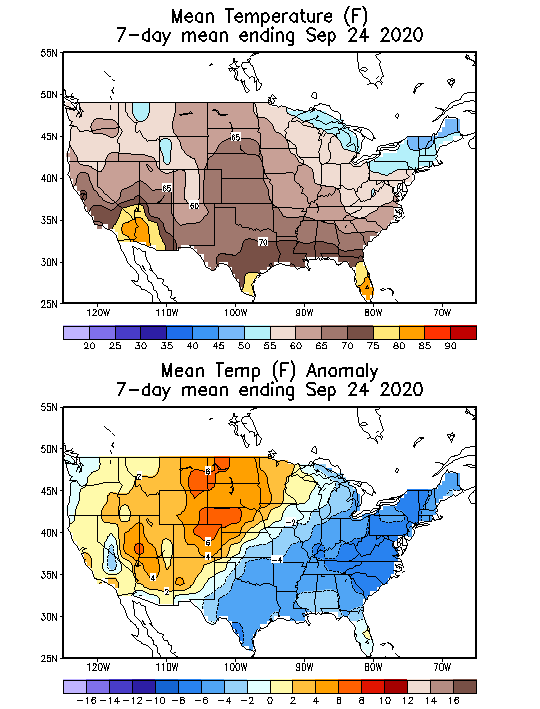
Source: National Oceanic and Atmospheric Administration
Deviation between average and normal (°F)
7-day mean ending Sep 24, 2020

Source: National Oceanic and Atmospheric Administration

